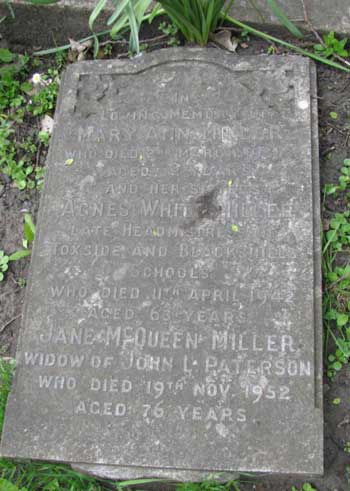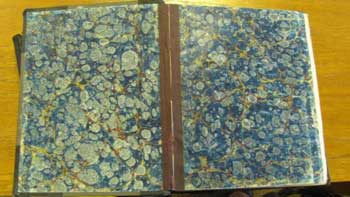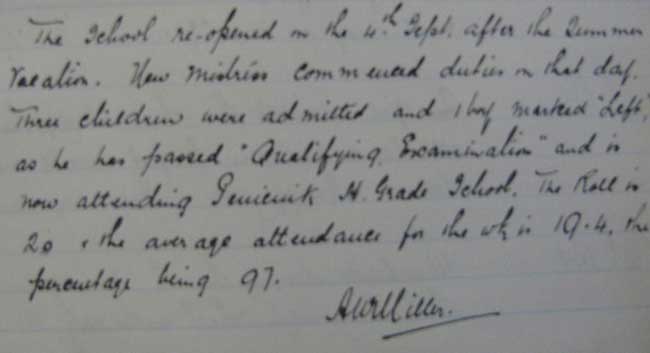Agnes White Miller
Born 1878/9. Died April 1942.
Research by Andrea Schwedler
Who is Agnes Miller?
I came across Agnes Miller's gravestone in Dalry cemetery. It's a simple, unadorned stone near the entry of the cemetery and close to the keeper's lodge. She is buried there with two other women, Mary and Jane, probably her sisters. What I found intriguing was the fact that Agnes Miller's profession is mentioned on the gravestone. I read this as a sign of professional pride. Pride which was also honoured by those who erected the gravestone in her memory. I wonder if Agnes Miller had to fight hard for her education, and whether she had to overcome a lot of resistance by family and friends and, last but not least, her own self-doubts and anxieties?

The text of the inscription reads:
In
loving memory of
MARY ANN MILLER
who died 2nd March 1937 (?)
aged 62 years
and her sister
AGNES WHITE MILLER
late headmistress of
Toxside and Blackshiels
Schools
who died 11th April 1942
aged 63 years
JANE MCQUEEN MILLER
widow of John L. Paterson
who died 19th Nov. 1952
aged 76 years.
After the Education (Scotland) Acts of 1861 and particularly 1872 middle-class women were encouraged to enter the teaching profession and we may assume that Agnes Miller was among the first generation of middle-class women for whom teaching was the only route to leading an independent life, even if she and thousands of other women were not on a par with their male colleagues. Women were generally paid less than men and tended to take up the less prestigious positions i.e. such as working in primary schools based in rural Scotland. Agnes Miller is a good example for this type of teacher who was also in charge of running the school.
Agnes was probably unmarried, otherwise she wouldn't have been able to retain her position in the school. I found her obituary in The Scotsman, 13th April 1942, p. 6 (on microfiche) in the Central Library in Edinburgh. The Librarian explained that professional people would have had their obituaries published in The Scotsman newspaper. Agnes Miller lived in Colinton (73 Redford Avenue) at some point in her life and died in 254 Morrison Street, her sister, Mrs Paterson's flat.
How was life as a Headmistress in a small rural school in Midlothian?
Midlothian Local Studies Centre in Loanhead holds three logbooks for Toxside School, which run from June 1892 to March 1956. Toxside School was situated in the South of Midlothian near Gladhouse Reservoir, around 14 km. south of Dalkeith on the A68. I looked this up in Explorer map 345 (Lammermuir Hills).

Inside pages, Toxside school logbook
The front and back of each logbook are in beautiful marbled paper. Agnes Miller took up her post in September 1922 and worked there until she moved on to Fala and Blackshiels School in April 1936.
Logbooks became mandatory with the introduction of the Scotland Education Act in 1872 which aimed to make schools more accountable and efficient. Agnes Miller's handwriting is very neat and fairly easy to read. She comes across as a very private person who introduced a few changes to make the teaching life for her children and herself a bit more bearable.

Agnes's logbook entry describing her first day at Toxside School, September 1922
Two months after having started her job Agnes got permission from the School Board to introduce a small change in the school hours so children who lived furthest away could leave school 15 minutes earlier during the winter months (logbook entry for 8th November 1922). In December 1925 she had a new stove installed, "making the room much more pleasant and comfortable" as she writes with some relief (entry for 21st December 1925).
The logbook entries always cover a week and provide factual information on pupils' attendance levels (numbers of boys and girls, weekly average and in percentage) which fluctuated very much from around 20 to as little as 8 pupils in the mid-1930s. Weather conditions and sicknesses are carefully noted. It is sad to note how many children were absent due to a variety of illnesses - mumps, colds, and measles. During sheep shearing season when children had to help their parents attendance went down again. Fairs (such as Dalkeith Fair) were also an occasion for children to miss school (entry of 21st March 1924).
Agnes Miller also put down how well the children did in particular subjects, and a sense of frustration can sometimes be read between the lines when children did less well than expected: "The three children in Junior I are not at all bright and work with them is slow and disappointing" (18th of January 1924). In spring of each year she puts down the names of girls and boys who had passed the Qualifying Examinations for high schools in the local area such as Dalkeith, Temple or Penicuik. There are usually between 3 and 5 children who would proceed to secondary education.
Because of the repetitive nature of the entries, one gets a good idea how difficult life must have been, both for the teacher and the children. It was a poor country school where children had to walk a long way across fields and streams, with some degree of danger to their lives: "The children from Huntley Lot came on Tuesday morning. The bridge is not yet repaired & the children are crossing the stream by means of a plank thrown across" (18th September 1925).
"This small moorland school continues to be very faithfully taught and much good work is accomplished under unfavourable circumstances (underlined in logbook) ... The children show a keen interest in their lessons (...) Needlework is very good, and Drawing, Singing and Drill receive a careful attention".
Extract from the Toxside School Inspection of 9th June 1902.
The school inspectors were churchmen (referred to as "correspondents") who would normally visit the school every six months. It's notable that, throughout the decades, reports are positive and supportive, stressing that school was managed well in very difficult conditions, for instance on 30th April 1928, when the inspector marks upon the "very happy relations which exist between the teacher and her pupils" or in another report of 19th July 1932: "the tone of the schoolroom continues to be exemplary".
Other comments by the inspectors have caught my attention. In the early 1890s inspector Blake misses a certain, shall we say, more UK-wide outlook: "The provision of a map of the British Isles as a whole is strongly recommended" (Blake, 30th April 1892). In 1910 the same inspector remarks that “a school globe and a wall map of Europe are required" (6th of July 1910).
There is also an increased awareness of the lack of sufficient hygiene and the call for a cleaner. The July 1910 inspection notes the "condition of the school floor" and "the inadequate cleaning of the school". "Arrangements should be made whereby the classroom and the offices may be kept in a proper sanitory condition by one especially appointed to the purpose". Regular visits by a dentist start in the 1920s.
It is not clear why Agnes Miller left Toxside School in April 1936. The logbook entry for 9th April 1936 is very short and factual, just stating that Agnes Miller "is being transferred to Fala and Foutra School". [sic] Ken Bogle, the Archivist at the Local Studies Archive in Loanhead, was not certain where Blackshiels School was based but assumes that this was probably Fala School in Blackshiels Farm which was close to Fala village. These school logbooks do not reveal any new information, apart from the fact that Agnes Miller retired from that post in September 1940.
I wonder if Agnes Miller was one of the thousands of women like Dorothea Brooke in George Eliot‟s "Middlemarch”, who toiled away in darkness, unloved and unrecognised. As the narrator in “Middlemarch” sums up Dorothea Brooke's life, with a mixture of hopefulness and despair:
"(...) for the growing good of the world is partly dependent on unhistoric acts and that things are not so ill with you and me as they might have been, is half owing to the number who lived faithfully a hidden life and rest in unvisited tombs" (Middlemarch, p. 785).
Sources used:
Local Studies Centre, Loanhead, Midlothian
- Three school logbooks for Toxside School (June 1892 to March 1956)
- Two school logbooks of Fala and Soutra School (June 1910 to March 1964)
Edinburgh Central Library
- Microfiche for The Scotsman, obituary for Agnes Miller (13th April 1942), p. 6
- Digital archive of The Scotsman (1817-1950)
- Explorer Map 345 (Lammermuir Hills)
Books
Jane McDermid: The Schooling of Working-Class Girls in Victorian Scotland.
Gender, Education and Identity.
London and New York: Routledge, 2005. 202p.
David Northcroft: Scots at School. An Anthology.
Edinburgh University Press, 2003. 304p.
Donald J. Withrington: Going to School.
National Museums of Scotland, 1997. 84p.
George Eliot: Middlemarch
Oxford University Press, 2008. 810p.